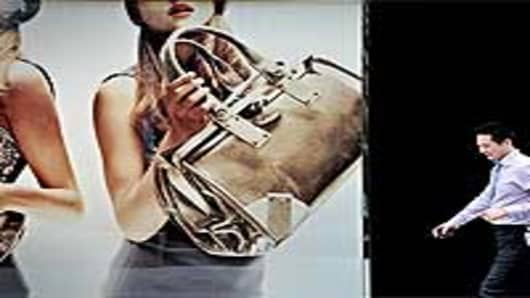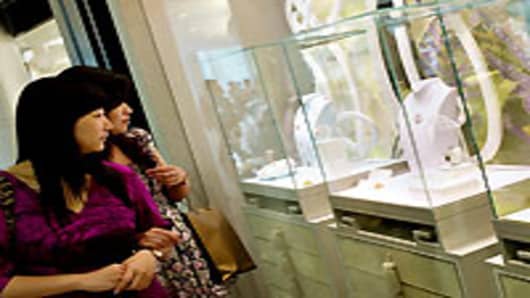As China’s millionaire population grows — Credit Suisse estimates it to more than double to 2.4 million by 2016 — one sector that is expected to ride this explosion in wealth is luxury goods.
Independent brokerage CLSA Asia Pacific Markets estimates luxury goods will be China’s fastest-growing consumer sector over the next 10 years with a annual growth rate of 20 percent.
Analysts say there are plenty of opportunities for investors in this space.
“Unlike other consumer discretionary products, the luxury goods sector is no longer a cyclical play, it’s a structural story. Some wealthy consumers will not cut back on their luxury spend even if there’s a slowdown, as the purchases do not represent a significant burden compared to their net worth,” Aaron Fischer, Head of Consumer & Gaming Research at CLSA Asia Pacific Markets, said.
Fischer estimates that mainland China and Hong Kong consumers will make up 44 percent of global luxury sales by 2020. The Greater China region contributed to about one third of total global sales at luxury power houses, Prada and Gucci in the first six months of 2011, according to latest company figures.
Fischer has a buy call on Prada, which is down about 3 percent from late June when it made its debut on the Hong Kong stock exchange. However, it has performed better than the broader Hong Kong market, which has fallen about 10 percent over the same period.
Fischer trimmed his one-year target price for Prada to HK$51.80 (US$6.60) in September, down from HK$61 previously, due to concerns about the slowdown in Europe.
Despite the adjustment, there’s still a potential 35 percent upside from current levels.
Fischer also has a buy call on international retailer of beauty and home products, L’Occitane. His target price of HK$23.90 for L’Occitane implies an upside of over 40 percent from current levels in the coming year.
Erwan Rambourg, Head of Consumer & Retail, Global Research at HSBC says that based on interviews with retailers about three-quarters of luxury products sold in China are to first time buyers. “That means there’s still huge potential for growth in the sector.”
One of his top picks is Hong Kong-listed luxury watch retailer, Hengdeli. His one-year price target of HK$4.20 implies a gain of about 48 percent over the next 12 months. Hengdeli has fallen nearly 40 percent since January. “This stock has been affected by a lot of noise about hard landing in China, and overblown micro issues. We think Hengdeli is undervalued, trading at 13 times 2012 price earnings.”
Besides the increase in spending on luxury goods in Mainland China and Hong Kong, the Chinese are also big shoppers when they travel abroad. Rambourg says investors can’t ignore the “tourist theme” when investing in China’s luxury boom. “About 25 percent of total sales for some of the top brands in Europe actually come from Chinese tourists’ spend, which is quite substantial.”
He has Switzerland-listed Richemont, which owns Cartier, Van Cleef & Arpels, plus France listed PPR, which manages the Gucci brand on his buy list, as stocks that’ll benefit from China’s growing wealth.
According to a report from HSBC, Asian consumers, excluding Japan, contributed about 40-50 percent to total sales at the above two companies in 2010.
Anne Le Borgne, portfolio manager at Amundi’s Global Luxury & Lifestyle Fund, says she’s confident the spending pattern of Chinese consumers both at home and abroad will stay resilient, even if the economy slows.
“There’s a strong willingness of Chinese consumers to spend on luxury items, as a way to display their wealth. Since 2003, consumption of luxury products in China has grown by about 30 percent annually, staying strong even in the last financial crisis,” Le Borgne said.
Amundi Global Luxury & Lifestyle Fund is registered in Luxembourg and has LVMH, Richemont and Christian Dior in its top 10 holdings list.
Gold Over Fashion
However, Eddie Tam, Chief Investment Officer at hedge fund Central Asset Investments, thinks that when it comes to luxury products, gold jewelers are a better bet than high fashion brands.
Chinese like to show off their wealth with high quality jewelry pieces, says Tam.
According to a recent Reuters report foreign luxury brands not traditionally focused on jewelry, such as Louis Vuitton and Chanel, are also beginning to see this space as a means to tap into China's appetite for luxury.
Gold is a good store of value, and over the long term is a more sustainable investment compared to luxury brands, says Tam. He expects Hong Kong’s listed gold jewelers to offer about 30 percent growth in the next few years.
Two gold jewelers listed in Hong Kong, Chow Sang Sang and Luk Fook, have outperformed the broader market this year.
Both are up more than 20 percent since January, and are now trading at forward P/Es of about 13 to 16 times, with P/E growth of less than 1.
Asian investors can look forward to more choices when the world’s largest jeweler Chow Tai Fook makes its debut on the Hong Kong stock exchange in mid-December.
All stock prices and estimates are based on November 14-15 levels




